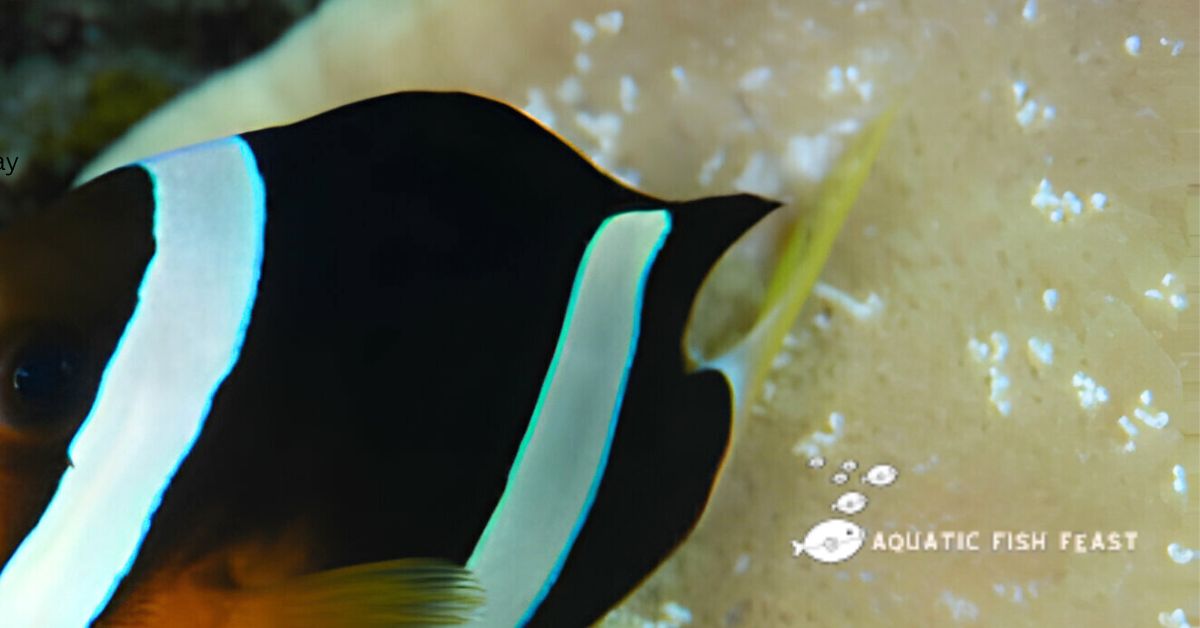Do you want to know when Clownfish lay eggs? Yes, I want to know when a clown lays eggs. Those who are new to Clownfish, like me, probably don’t know much about them yet.
You already know they’re colorful and straightforward to care for, but you may be interested in learning more.
When, for example, do clownfish deposit eggs? What is the process through which Clownfish reproduce? Do these fish lay eggs, or do they reproduce?
But it won’t be a problem. Keep reading to learn everything you need to know about clownfish reproduction. This will help you understand the Clownfish better if you choose to breed them in the future.
Table of Contents
Now, let’s get started.
How To Determine If Clownfish Is Ready To Lay Eggs
You may tell whether the spawning cycle is approaching by attentively observing her physical look and behavior.
The indicators that your Clownfish is going to spawn are listed below:
1. Massive Abdomen
Enlargement or swelling in the abdomen midsection of your Clownfish is one of the first signals that the egg-laying process has begun.
- This occurs while the female prepares for pregnancy.
- Her tummy is expanding due to the expansion of the egg-producing organ.
- However, this symptom is inadequate because it may also be caused by stress or disease.
- As a result, you should seek further indicators.
2. Protrusion that looks like a tube
Aside from the rise in abdomen size, you may observe additional changes in the bodies of your Clownfish.
- The male and female Clownfish’s bodies will develop tube-like protrusions.
- These protrusions are the mating organs required for breeding.
- These tubes are necessary for spawning and sperm fertilization.
3. aggressiveness
Clownfish are generally peaceful. The female Clownfish, on the other hand, might become hostile while laying eggs.
The female Clownfish will be highly protective of her tankmates and will not allow them to approach her.
- She could bite them or chase them away.
- This aggressiveness is just transitory since she needs a safe area to spawn.
4. Nest Construction
The construction of a nest is another sign that your Clownfish will spawn.
The female Clownfish will locate an appropriate location in the tank to lay her eggs.
The preferred location is generally a firm and flat surface near the aquarium’s bottom.
The male Clownfish will clean up the area and dig tunnels in the gravel.
The couple guards the nest until the eggs hatch.
What Are The Conditioning For Clownfish Eggs
Once you’ve set up your breeding tank and the couple is in there, you’ll need to focus on two things. The first is the water quality, and the second is the diet.
Lowering the salinity of your tank is typically ideal for clownfish reproduction. A specific gravity between 1.020 and 1.022 should suffice for most applications.
In addition, most aquarists advocate increasing the temperature of the reproductive aquarium to 83-84 °F. The water should be crystal clear, low in nitrates, and free of ammonia and nitrite.
In addition to water quality, it is essential to consider the nutritional needs of the pair. To ensure successful spawning and raising of the fry, the individuals must be in optimal physical condition.
Additionally, providing enough food to support the potential future offspring is crucial.
Live fish meals are a terrific alternative for your Clownfish, especially during this time of year. Additionally, frozen foods and high-quality commercial foods work well.
It would help to feed your companion three to five times per day or as much as they consume.
Remove any uneaten meals as soon as possible since they can quickly foul the aquarium water!
What Kind Of Eggs Does Clownfish Lay
The eggs laid by Clownfish are typically between two and four millimeters in diameter and resemble tiny poppy seeds.
The eggs can be any color when first deposited, ranging from a bright orange to a transparent white. The primary color of both parent organisms determines the hue.
As a result of the stickiness of the eggs, they will adhere to the surface. If a suitable slate or cave is nearby, your Clownfish will most likely choose to deposit its eggs on top of it rather than anywhere else.
The eggs will grow and transform into a characteristic cylinder shape for three to four days. Their bodies are a little orange hue, and their eyes are pretty open and prominent.
Where Do Clownfish Lay Their Eggs
Clownfish have a preferred location within their territory, and just like people’s bedrooms, this is where they spend most of their time.
Just a few days before the beginning of the breeding season, you could notice anything odd. This metaphor describes the process as if a clownfish were cleaning up the area, removing the scattered gravel and stones, and preparing it for the new arrival.
The location may be on a clay pot or plate, within an anemone, or even in the middle of a coral reef. Clownfish prefer to do so when reproducing and depositing eggs on a structurally sound and stable surface.
When breeding clownfish eggs regularly, aquarists would place a clay pot or tiles at the bottom of the tank at a location where the female Clownfish can deposit her eggs.
After fertilization, the aquarists remove the clay pot containing the clownfish eggs, and the young fish are then raised in separate aquariums.
How Many Eggs Do Clownfish Lay
There have been reports of Clownfish laying anything from 100 to 1,500 eggs in a single occurrence. During spawning, the typical couple will pledge between 400 and 500 eggs.
The egg output of a clownfish might vary depending on the following factors:
1. Types of Animals
The couple’s relative age and health might affect their chances of reproducing since healthier offspring are more fertile.
2. The food consumed by Clownfish.
Larger fish, such as the maroon clownfish, may each simultaneously generate up to one thousand eggs. However, smaller species have considerably more limited populations, numbering in the hundreds at most.
What To Do When Clownfish Lay Eggs
You’ve discovered that your tank’s resident Clownfish has placed eggs in one of the compartments of the aquarium. What steps should you take at this time?
Because the parents of the Clownfish will tend to the eggs, you are not required to do anything else. It would help if you merely continued providing the standard level of care for the fish.
Maintain the routine of feeding the fish and watch to see that the water’s parameters remain within the appropriate range.
If you want to increase the likelihood that most of the eggs will hatch, you may monitor how things are progressing and monitor how they develop.
The first time you breed, Clownfish is a thrilling experience, but it’s doubtful that you’ll want to play an active role until the fishing’s emerge from their eggs.
If you want to promote healthy reproduction, put the Clownfish in a breeding tank where they won’t be distracted by other fish. This will make it easier for you to accomplish your goal.
Aside from that, there shouldn’t be a need for you to take any other particular measures. Keep a watchful lookout for the moment when the eggs begin to hatch.
How To Properly Care For Clownfish Eggs
Provide a safe environment for clownfish eggs, maintain high water quality, employ specific equipment for egg raising, keep the eggs clean, and protect them from predators.
Attach specialized egg-protecting devices to the tank’s sides as well.
Raising clownfish fry is an exciting aspect of clownfish breeding. The newborn Clownfish require specific care once the eggs hatch to ensure their survival and maturation into healthy juvenile Clownfish.
1. Create a Secure Environment
The first step in caring for clownfish eggs is to provide a safe habitat for them. Clownfish eggs are fragile and easily injured. It is advised that these delicate eggs be transferred to a separate tank.
This container should not have sharp edges or rough surfaces that might harm embryos. A sponge filter or air stone can offer mild water circulation to keep the eggs clean.
2. Maintain Adequate Water Quality
Maintaining proper water quality for the healthy development of eggs is critical whether you’re breeding Clownfish for business or pleasure. The tank water temperature should be kept steady, and the salinity should be between 1.023 and 1.025.
3. Utilize Egg Rearing Equipment
You may require additional equipment and a separate tank to care for eggs. The essential equipment heater with a thermostat must keep the tank temperature consistent.
A tiny circulation pump can also provide a gentle water flow around the eggs. Finally, a hydrometer may be used to determine the salinity of water.
4. Maintain the Eggs’ Cleanliness
To prevent fungus from forming, clownfish eggs must be kept clean. To eliminate dirt and garbage, gently swirl the water in the tank. Avoid immediately handling the eggs, as this might harm them.
Final Thought
Now that we have established When do Clownfish lay eggs, to summarize, Clownfish, like most other fishes, deposit eggs.
This fish is naturally timid, but with careful and patient care, they may become gregarious companions and reproduce cheerfully.
Raising newborn Clownfish from eggs in your reef tank is a fantastic pastime. Congratulations if you have a couple of Clownfish who have gone broody and laid eggs! And I hope you find my blog interesting. Thank you for taking the time to read this.
OTHER ARTICLES:
Can Clownfish Reproduce Asexually
Can Clownfish Change From Female To Male
What Is Fish Production: A Global Perspective
How Often Do Fish Mate (Unlocking The Secrets In Depth)




